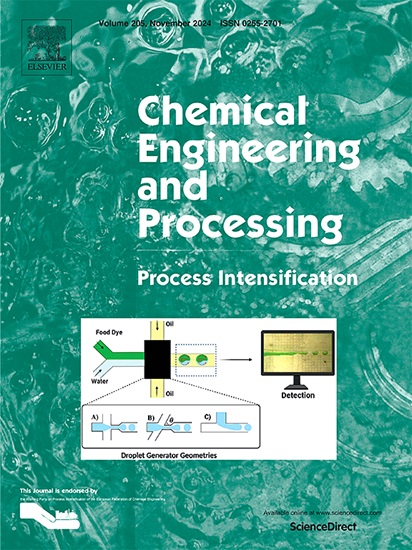微流控系统中通道结结构的CFD模拟:可持续重金属提取和环境修复的参数分析
IF 3.8
3区 工程技术
Q3 ENERGY & FUELS
Chemical Engineering and Processing - Process Intensification
Pub Date : 2025-06-24
DOI:10.1016/j.cep.2025.110422
引用次数: 0
摘要
液液萃取与微流控技术的结合代表了分离科学的重大进步,特别是在污染修复和资源回收等环境应用方面。这种组合解决了传统LLE方法的主要局限性,并提供了更高的效率,使其成为可持续化学过程的有前途的方法。本研究以双2-乙基己基磷酸(D2EHPA)为萃取剂,癸烷为溶剂相,在Y-Y微通道中对环境相关污染物Co (II)离子进行了CFD模拟。系统探讨了进口角(30-180°)和出口角(30-90°)等几何参数对抽提性能的影响。此外,通过广泛的参数扫描评估了操作条件,包括水相pH为4.4-8,有机与水相流量比为0.5-3,Co (II)初始浓度为5-25 mM,萃取剂浓度为10-30 mM。研究表明,微通道的进口角度对萃取效率有显著影响,进口角度从30°增加到120°,由于相混合的改善,萃取效率得到了提高。与t形进气道相比,y形进气道具有更好的抽气性能。通过模拟趋势和局部响应面分析,确定了最适宜的工艺条件:进口角为132°,出口角为77°,pH为7.13,Co (II)初始浓度为21.6 mM,萃取剂浓度为27.2 mM,流量比为2.53。在此条件下,提取效率为84.46%。这些发现突出了微流控LLE系统在环境应用方面的潜力,包括重金属污染的修复、可持续采矿作业中分离效率的提高,以及用于快速、小规模环境监测的生态友好型芯片实验室技术的发展。本文章由计算机程序翻译,如有差异,请以英文原文为准。

CFD simulation of channel junction configurations in microfluidic systems: Parametric analysis for sustainable heavy metal extraction and environmental remediation
The integration of liquid-liquid extraction (LLE) and microfluidic technology represents a significant advancement in separation science, particularly for environmental applications such as pollution remediation and resource recovery. This combination addresses key limitations of traditional LLE methods and offers enhanced efficiency, making it a promising approach for sustainable chemical processes. In this study, CFD simulation was conducted to extract Co (II) ions—an environmentally relevant contaminant—using di-2-ethylhexylphosphoric acid (D2EHPA) as the extractant and decane as the solvent phase in a Y-Y microchannel. The influence of various geometrical parameters, such as inlet angle (30-180°) and outlet angle (30-90°), were systematically explored to evaluate their influence on extraction performance. Additionally, Operating conditions included an aqueous phase pH of 4.4-8, an organic-to-aqueous phase flowrate ratio of 0.5-3, an initial Co (II) concentration of 5-25 mM, and an extractant concentration of 10-30 mM were assessed through extensive parametric sweeps. The study revealed that the microchannel's inlet angle significantly affected extraction efficiency, with angles increasing from 30° to 120° leading to enhanced efficiency due to improved phase mixing. The Y-shaped inlet demonstrated superior extraction performance compared to the T-shaped inlet. By analyzing simulation trends and local response surfaces, the most suitable conditions were determined: inlet angle of 132°, outlet angle of 77°, pH of 7.13, initial Co (II) concentration of 21.6 mM, extractant concentration of 27.2 mM, and flow rate ratio of 2.53. Under these conditions, an extraction efficiency of 84.46 % was achieved. These findings highlight the potential of microfluidic LLE systems for environmental applications, including the remediation of heavy metal pollution, improved separation efficiency in sustainable mining operations, and the development of eco-friendly lab-on-a-chip technologies for rapid, small-scale environmental monitoring.
求助全文
通过发布文献求助,成功后即可免费获取论文全文。
去求助
来源期刊
CiteScore
7.80
自引率
9.30%
发文量
408
审稿时长
49 days
期刊介绍:
Chemical Engineering and Processing: Process Intensification is intended for practicing researchers in industry and academia, working in the field of Process Engineering and related to the subject of Process Intensification.Articles published in the Journal demonstrate how novel discoveries, developments and theories in the field of Process Engineering and in particular Process Intensification may be used for analysis and design of innovative equipment and processing methods with substantially improved sustainability, efficiency and environmental performance.

 求助内容:
求助内容: 应助结果提醒方式:
应助结果提醒方式:


